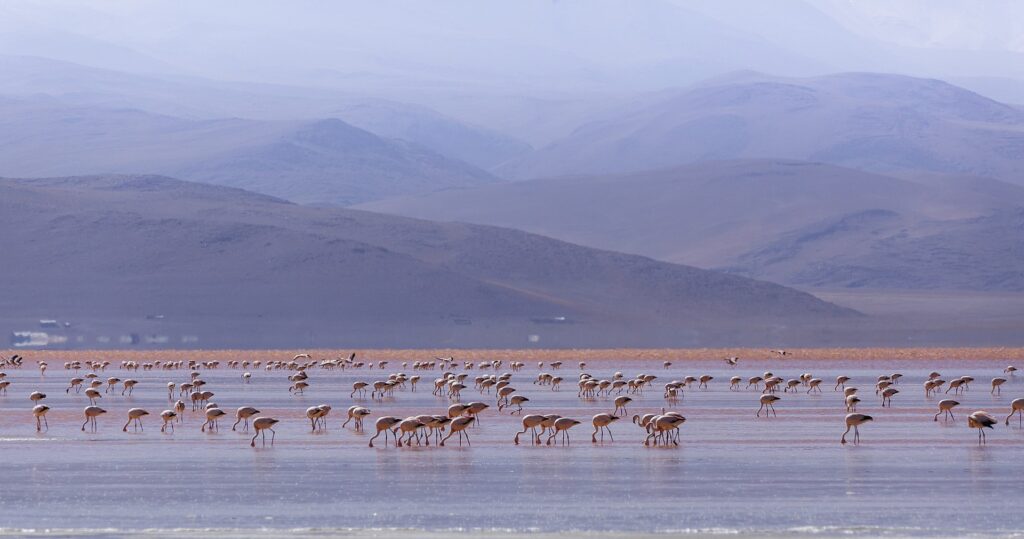flamant (F)
fenicottero (I)
pájaro raro (S)
flamingo (G)
flamingo (P)
atacama desert, chile
The Atacama Desert runs along the Pacific Ocean in the north of Chile for about 900 miles. It’s tucked in between the Andes mountains, the Chilean Coastal Range and the Pacific Ocean. The Atacama is the driest non-polar desert in the world and the second driest desert in the world after the McMurdo Dry Valleys, which are valleys in Antarctica without snow. The Atacama’s precipitation comes mostly from fog, not rain. Fog forms when warm air hits a cooler object, such as a mountain. The areas in the Atacama where fog forms are known as lomas.
Incidentally, do you know where the driest place on (or rather above) Earth is in terms of relative humidity? The first or business class section of an airliner. Airplane cabins are dry, way below 15% relative humidity. (The Boeing 787 is touted as having humidity levels that are the best in the business at 15%). First class is even drier than economy class because there are less people giving off humidity (mostly by breathing). So, those people in first class might have more legroom and better food but they are just withering away up there in the front of the plane. (Hopefully, that will make you feel better if you’re reading this post in a middle seat in the back of an airplane.) Maria Elena South in the Atacama has recorded relative humidity of 17.3 % so more humid than an airplane cabin.
The Atacama doesn’t have a lot of animal life and what life there is lives in the lomos. But it does have quite a bit of bird life, including the rufous collared sparrow (Rufuous!!!); Humboldt penguins that live along the coast; and….two kinds of flamingos. (You knew we’d get to our Word.) The Andean flamingo lives on salt flats high up in the mountains and the Chilean flamingo lives along the coast. Flamingos are found throughout the Americas; in fact, the flamingo is the national bird of the Bahamas. Scientists aren’t sure why they are often seen standing on one leg. When they walk, it looks like their legs are bending backwards. This is because what we would call their knee is actually their ankle. They filter feed with their head curled around so far that their chin is facing towards the sky. They are also known for living in very large, noisy groups. What are those groups called? No, not a Liberace but a flamboyance. (Entschuldigung for that joke.)

Andean flamingos in the Atacama, 2017, taken by Thomas Fuhrmann, Snowman Studios
One of the world’s more famous flamingos is Yo-yo, the flamingo featured in Disney’s Fantasia 2000. Fantasia 2000 was a sequel to the original Fantasia released in 1940, which featured eight animated segments set to classical music. One of the original’s most famous segments features Mickey Mouse as the Sorcerer’s Apprentice, set to music of the same name composed by Paul Dukas. The apprentice decides to cast some of the Sorcerer’s spells but things get slightly!! out of hand. The name of the Sorcerer? Yen Sid…..try spelling it backwards.
Like the original, Fantasia 2000 featured eight animated segments (one of which was the original Sorcerer’s Apprentice segment) set to classical music. The music for the segment featuring our hero, Yo-yo the flamingo, is the finale of the Carnival of the Animals by the French composer Camille Saint-Saens. James Earl Jones, aka Darth Vader, introduces the audience to Yo-yo, positing that the upcoming segment will answer an age-old question: “What is man’s relationship to nature”; only to be handed a note that forces him to correct the age-old question to: “What would happen if you gave a yo-yo to a flock of flamingos?” The segment goes on to show Yo-yo, a free-spirited flamingo possessing at least one yo-yo, being temporarily subdued but ultimately triumphing over his routine-obsessed fellow flamingos.
How long has the yo-yo been around? Well, at least since 440 CE in Ancient Greece. It was called a bandalore in the 1600s. The origin of the word yo-yo is likely a word from the Philippines. But it really got popular in America in the 1900’s. The Yo-yo Manufacturing Company opened in 1928 in Santa Barbara, California. Its owner, Pedro Flores, an immigrant from the Philippines, manufactured a yo-yo with a looped slip-string that allowed for better control and the ability to do tricks, such as making the yo-yo sleep. Legend has it that Mr. Flores also worked at a hotel where he was spotted playing with one of his yo-yos by Donald F. Duncan, who eventually bought the Yo-yo Manufacturing Company in 1932, changing the name to the Duncan Toys Company. Yo-yos were marketed using trick demonstrations and the term “yo-yo” was trademarked.
In the 1960’s, Duncan Toys embarked on an aggressive advertising campaign to bolster sales. If you grew up in the 1960s or early 1970s in the United States, you definitely had a yo-yo. The yo-yo was one of ten toys which was launched on the space shuttle Discovery on April 12, 1985.
But the yo-yo’s popularity became a double-edged sword for the Duncan Toys company. In 1965, a court ruled that the term “yo-yo” had become part of common speech (or genericized) such that Duncan Toys Company no longer had exclusive rights to the term and other companies could use the term to market their products. (You trademark lawyers, feel free to comment.) In 1968, the Duncan family sold the company name and its trademarks to Flambeau Plastics, which continued to manufacture the yo-yos.
Genericization can be a real problem for companies. Some of the other products whose trademarks eventually became generic terms are escalators; a thermos; and a trampoline. Please pass the Kleenex while I put a Band-aid on my finger.